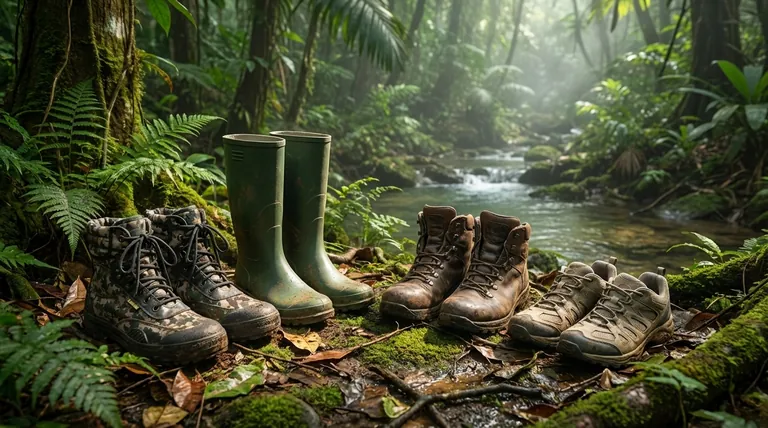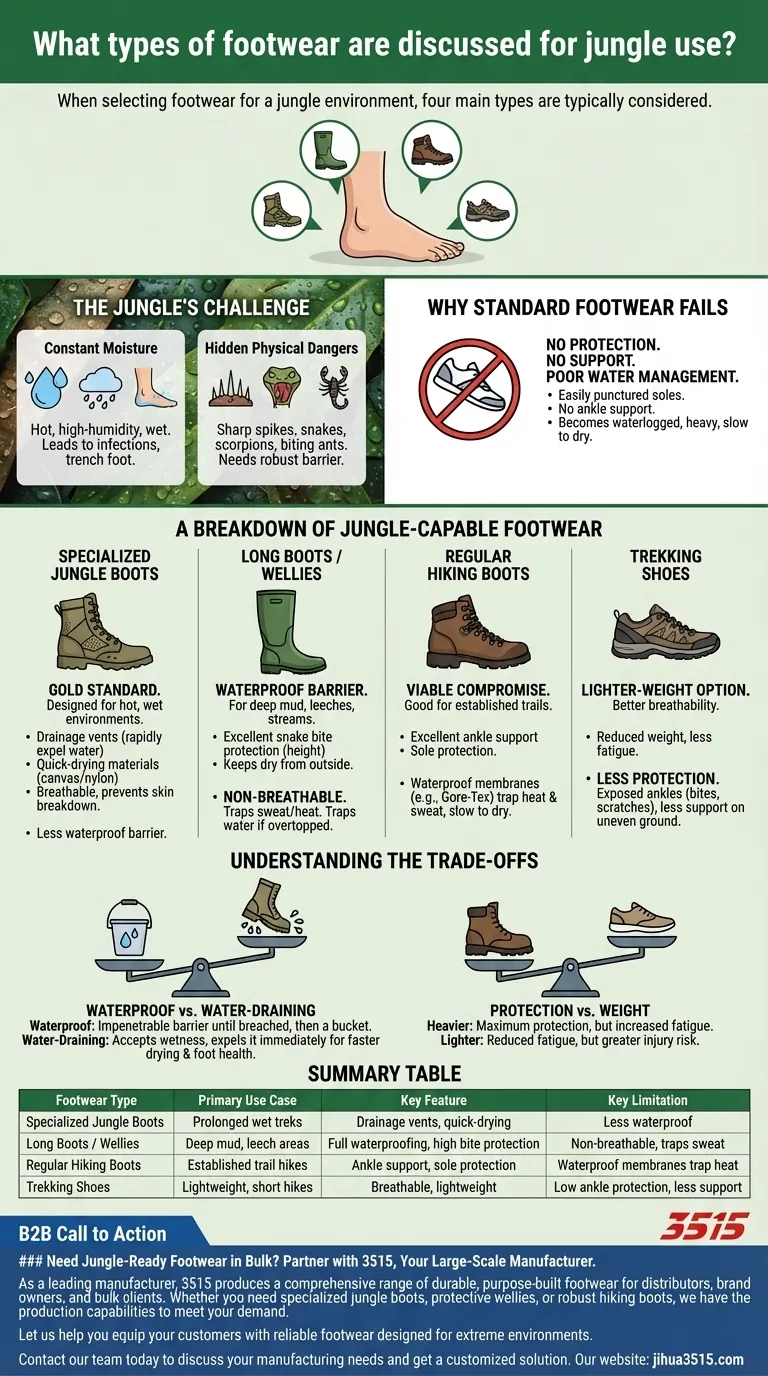When selecting footwear for a jungle environment, four main types are typically considered. These are specialized jungle boots, tall wellies or long boots, standard hiking boots, and lighter trekking shoes. Each option represents a different strategy for dealing with the jungle's two primary challenges: constant moisture and physical hazards from the ground up.
The core challenge in the jungle is not keeping your feet perfectly dry, which is often impossible, but protecting them from physical harm while effectively managing moisture. Specialized jungle boots are purpose-built for this, prioritizing rapid drainage and quick-drying materials over a waterproof seal.

Why Standard Footwear Fails
Before exploring the right options, it's crucial to understand why your everyday shoes are inadequate. The jungle environment presents a unique combination of threats that renders most footwear not only uncomfortable but dangerous.
The Constant Threat of Moisture
The jungle is a hot, high-humidity, and extremely wet environment. Your feet will get wet, either from external water or from sweat trapped inside a non-breathable shoe.
This constant dampness can lead to severe foot health issues, including fungal infections, blisters, and immersion foot (trench foot), where the skin begins to break down.
Hidden Physical Dangers
The jungle floor is not a smooth path. Your feet are the part of your body most in contact with unseen hazards.
These dangers include sharp spikes from plants, venomous snakes, scorpions, and biting ants. Footwear must provide a robust barrier against punctures and bites.
The Problem with Tennis Shoes and Minimalist Footwear
Normal tennis shoes, barefoot-style shoes, or other lightweight footwear offer almost no protection.
Their soles are easily punctured, they provide no ankle support against sprains or bites, and they manage water poorly, becoming waterlogged, heavy, and slow to dry.
A Breakdown of Jungle-Capable Footwear
The four viable options for jungle footwear each have a distinct philosophy of use. Your choice depends on the specific conditions you expect to face.
Specialized Jungle Boots
These are the gold standard, designed by military forces for operating in hot, wet environments. Their core design feature is not to keep water out, but to let it escape quickly.
They feature drainage vents or ports near the instep to let water out as you walk, and they are constructed from quick-drying materials like canvas and nylon that don't hold moisture. This design allows the foot to breathe and dry rapidly, preventing skin breakdown.
Long Boots / Wellies
Also known as Wellington boots, these create a completely waterproof barrier. Their primary advantage is in keeping you dry while crossing streams or traversing deep mud and leech-infested terrain.
They provide excellent protection against snake bites due to their height. However, they are not breathable and will trap sweat, making them very hot and potentially causing moisture issues from the inside out. If water overtops them, it becomes trapped.
Regular Hiking Boots
A sturdy pair of leather or synthetic hiking boots can be a viable compromise, offering excellent ankle support and sole protection.
However, many modern hiking boots feature waterproof membranes (like Gore-Tex). While great for temperate climates, these membranes trap heat and sweat in the jungle's humidity and are notoriously slow to dry once saturated. A non-waterproof hiking boot is often a better choice.
Trekking Shoes
These are a lighter-weight option, essentially a low-cut version of a hiking boot. They offer better breathability than a full boot.
The trade-off is significantly less protection. Their low cut leaves the ankle exposed to bites, scratches, and leeches, and they provide less support on uneven, slippery ground.
Understanding the Trade-offs
Choosing the right footwear is a matter of balancing competing priorities. There is no single "perfect" boot for every situation.
Waterproof vs. Water-Draining
This is the most critical decision. A waterproof boot (like a welly) aims to create an impenetrable barrier. This works until water gets inside, at which point the boot becomes a bucket, trapping moisture against your skin.
A water-draining boot (a true jungle boot) accepts that your feet will get wet. Its goal is to expel that water immediately and dry as fast as possible, which is a far more effective strategy for long-term foot health in perpetually wet conditions.
Protection vs. Weight
Heavier boots with thick soles and high ankle coverage offer maximum protection from punctures and bites. However, this extra weight increases fatigue over long distances.
Lighter trekking shoes reduce fatigue but expose you to greater risk of injury from both the environment and a lack of ankle support.
Making the Right Choice for Your Goal
Select your footwear based on the most likely conditions you will face.
- If your primary focus is prolonged treks in constantly wet conditions: Choose a specialized jungle boot with drainage vents for superior moisture management and foot health.
- If your primary focus is navigating deep mud or swampy, leech-infested areas: Opt for tall, waterproof wellies to create a reliable physical barrier.
- If your primary focus is shorter hikes on well-established trails: A durable, non-waterproof hiking boot can provide a good balance of support and protection.
Ultimately, the best strategy is to protect your feet from the jungle floor while allowing them to breathe and dry quickly, rather than fighting a losing battle to keep them perfectly dry.
Summary Table:
| Footwear Type | Primary Use Case | Key Feature | Key Limitation |
|---|---|---|---|
| Specialized Jungle Boots | Prolonged wet treks | Drainage vents, quick-drying materials | Less waterproof barrier |
| Long Boots / Wellies | Deep mud, leech areas | Full waterproofing, high bite protection | Non-breathable, traps sweat |
| Regular Hiking Boots | Established trail hikes | Ankle support, sole protection | Waterproof membranes trap heat |
| Trekking Shoes | Lightweight, short hikes | Breathable, lightweight | Low ankle protection, less support |
Need Jungle-Ready Footwear in Bulk? Partner with 3515, Your Large-Scale Manufacturer.
As a leading manufacturer, 3515 produces a comprehensive range of durable, purpose-built footwear for distributors, brand owners, and bulk clients. Whether you need specialized jungle boots with drainage systems, protective wellies, or robust hiking boots, we have the production capabilities to meet your demand for all types of shoes and boots.
Let us help you equip your customers with reliable footwear designed for extreme environments.
Contact our team today to discuss your manufacturing needs and get a customized solution.
Visual Guide

Related Products
- Wholesale High-Traction Camo Boots - Custom Manufacturer for Brands
- Durable Spiked Camouflage Boots Wholesale & Factory Production
- Factory Direct Wholesale Rain Boots Durable Waterproof & Fully Customizable
- Safety Footwear Wholesale Manufacturer for Custom OEM/ODM Production
- Wholesale Waterproof Tactical Boots Custom Suede & High-Traction Soles
People Also Ask
- What is the name of the new boot model mentioned in the article? Introducing the Boots Original Camo Red Desert
- How did camouflage use develop during the World Wars? From Artistic Disruption to Scientific Concealment
- What benefits do the men's camo boots provide? Superior Protection & Comfort for Demanding Terrain
- What are the key features of the new line of camo boots? Built for Extreme Cold & Rugged Terrain
- Why might wearing multiple pairs of socks be counterproductive? Avoid This Common Cold-Weather Mistake



















